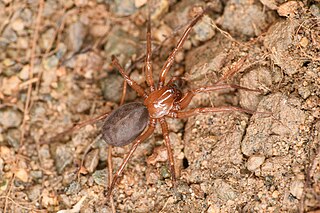
The Araneomorphae are an infraorder of spiders. They are distinguishable by chelicerae (fangs) that point diagonally forward and cross in a pinching action, in contrast to the Mygalomorphae, where they point straight down. Araneomorphs comprise the vast majority of living spiders.

Crevice weaver spiders (Filistatidae) comprise cribellate spiders with features that have been regarded as "primitive" for araneomorph spiders. They are weavers of funnel or tube webs. The family contains 18 genera and more than 120 described species worldwide.

Cybaeidae is a family of spiders first described by Nathan Banks in 1892. The diving bell spider or water spider Argyroneta aquatica was previously included in this family, but is now in the family Dictynidae.

Rhetenor is a genus of beetle mimicking jumping spiders that was first described by Eugène Louis Simon in 1902. As of August 2019 it contains only two species, found only in the United States and Brazil: R. diversipes and R. texanus. The name is a reference to Rhetnor, a character in Ovid's Metamorphoses.

Zygoballus is a genus of jumping spiders found in North and South America.

Microstigmatidae is a small family of spiders with about 38 described species in eleven genera. They are small ground-dwelling and free-living spiders that make little use of silk.

Homalonychus is a genus of araneomorph spiders, and is the only genus in the family Homalonychidae. It was first described by George Marx in 1891. As of October 2023 it contains only two species: H. selenopoides and H. theologus. They are found in the southern United States and Mexico: H. theologus is mostly found west of the Colorado River, while H. selenopoides is mostly found to the east, with some populations in Death Valley and near Mercury, Nevada.
Livius is a genus of South American tangled nest spiders containing the single species, Livius macrospinus. It was first described by V. D. Roth in 1967, and has only been found in Chile.
Neoapachella is a monotypic genus of North American mygalomorph trapdoor spiders in the family Euctenizidae containing the single species, Neoapachella rothi. It was first described by Jason Bond & B. D. Opell in 2002, and has only been found in Arizona and New Mexico. They are small to medium-sized spiders, reaching about 20.7 mm (0.81 in) in body length. It is named in honor of the Apaches as well as arachnologist Vincent D. Roth.
Urepus is a genus of South American tangled nest spiders containing the single species, Urepus rossi. It was first described by V. D. Roth in 1967, and has only been found in Peru.
Virgilus is a genus of South American tangled nest spiders containing the single species, Virgilus normalis. It was first described by V. D. Roth in 1967, and has only been found in Ecuador.
Neotegenaria is a genus of South American funnel weavers containing the single species, Neotegenaria agelenoides. It was first described by V. D. Roth in 1967, and has only been found in Guyana.
Olbus is a genus of South American corinnid sac spiders first described by Eugène Simon in 1880 as a huntsman spider. It was moved to the sac spider family in 1988, then to the Corinnidae in 2001.
Paratheuma is a genus of cribellate araneomorph spiders in the family Dictynidae, and was first described by E. B. Bryant in 1940. Originally placed with the ground spiders, it was transferred to the intertidal spiders in 1975, and to the Dictynidae in 2016.
Mizaga is a genus of West African cribellate araneomorph spiders in the family Dictynidae, and was first described by Eugène Simon in 1898. As of May 2019 it contains only two species, both found in Senegal: M. chevreuxi and M. racovitzai. Originally placed with the funnel weavers, it was moved to Dictynidae in 1967.

Filistatinella is a genus of North American crevice weavers that was first described by Willis J. Gertsch & Wilton Ivie in 1936. They are 1.5 to 3.5 millimetres long, and have a dark brown abdomen, longer than wide, with a few gray scales.
Lizarba is a monotypic genus of South American dwarf sheet spiders containing the single species, Lizarba separata. It was first described by V. D. Roth in 1967, and has only been found in Brazil.
Neocryphoeca is a genus of North American araneomorph spiders in the family Cybaeidae, and was first described by V. D. Roth in 1970. As of May 2019 it contains only two species, both found in the United States: N. beattyi and N. gertschi. Originally placed with the funnel weavers, it was moved to the Cybaeidae in 1983.
Nodocion is a genus of ground spiders that was first described by R. V. Chamberlin in 1922.
Naevius is a genus of South American tangled nest spiders first described by V. D. Roth in 1967.







